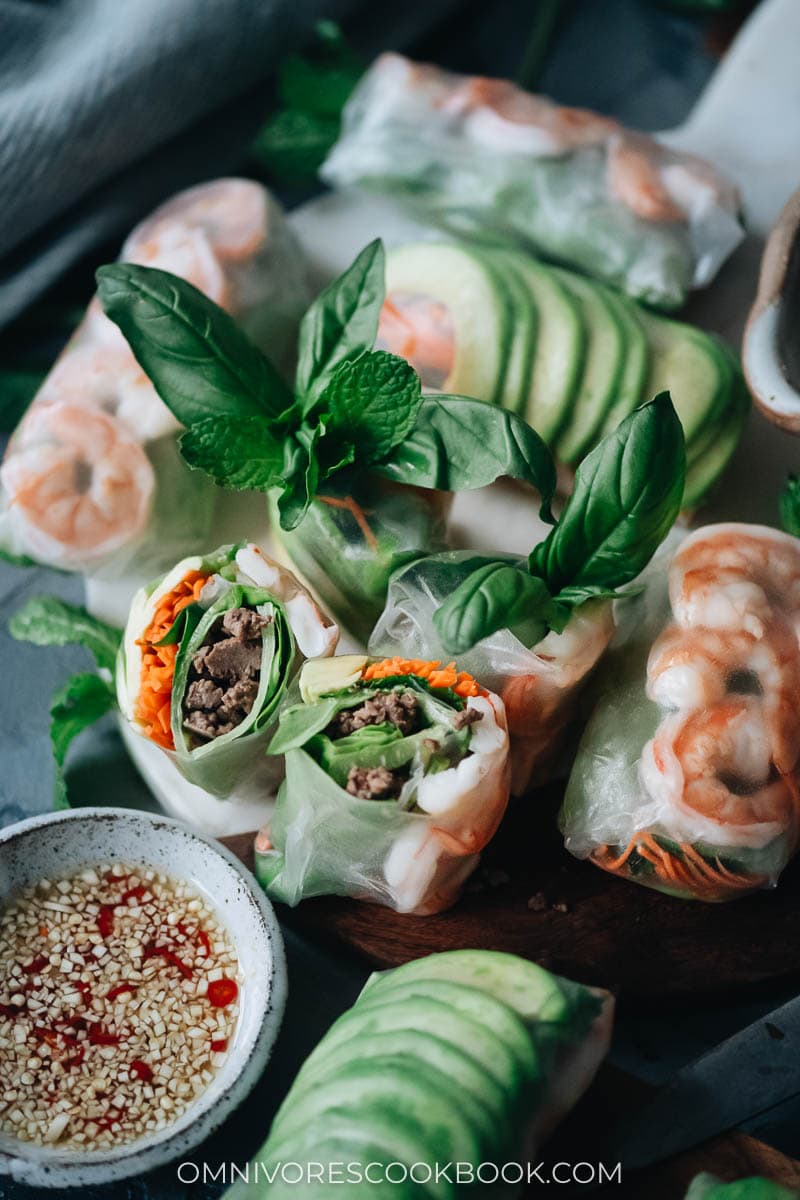
I love the crunch of fried egg rolls, but there are many times I would rather eat something healthier. That’s where my fresh spring rolls come in. I’m sure you’ve ordered these many times when going out to eat at a Vietnamese or Thai restaurant. They’re so light, refreshing, and addictive that it’s easy to eat healthy.
Why this recipe
A truly versatile fresh spring roll guide
My recipe for these fresh spring rolls is a guide that will help you make them the way that you want. I’ve included 2 types of protein in mine, shrimp and ground meat (beef, pork, or chicken), but you can always do one or the other if you prefer. You can also make it meatless and add more veggies. Sometimes, having it without any meat is wonderful, especially if you’re tired of eating ordinary salads. It’s like a hand-held salad that you dip into the dressing!
Two sauces
Speaking of dipping, I have 2 sauces for you. One is a Chinese-inspired nutty sesame sauce. It’s a bit like peanut sauce but with even more flavor. The other one is a Vietnamese chili sauce. I can never choose just one so I make both and alternate dunking in each.
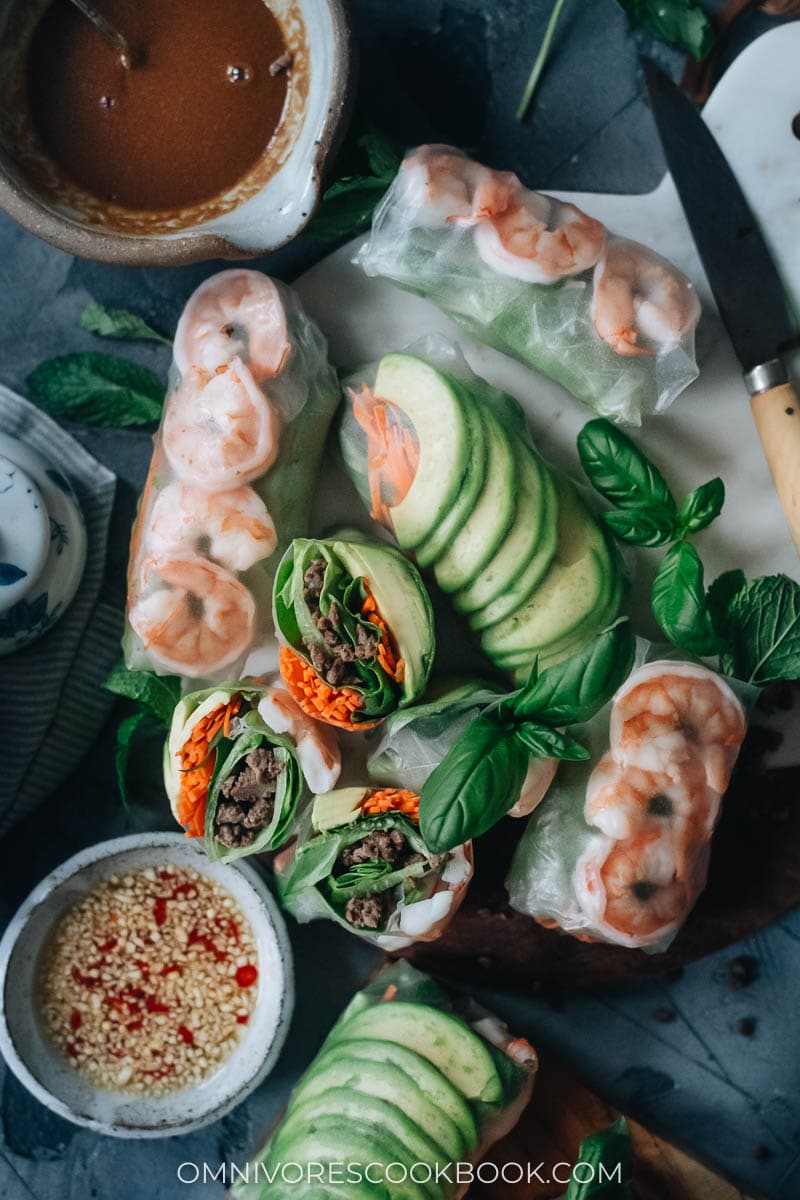
Ingredients
Rice paper
Fresh spring rolls are also called rice paper rolls. Like its name suggests, you will need to use dried rice paper to wrap them. You can find the rice paper at an Asian market, on the non-refrigerated shelves. You can also find them on Amazon.
NOTE: These rice papers come in very different sizes for various purposes. Make sure the wrappers are 22 cm (8.6”) in diameter or of similar size, to make the fresh spring rolls.
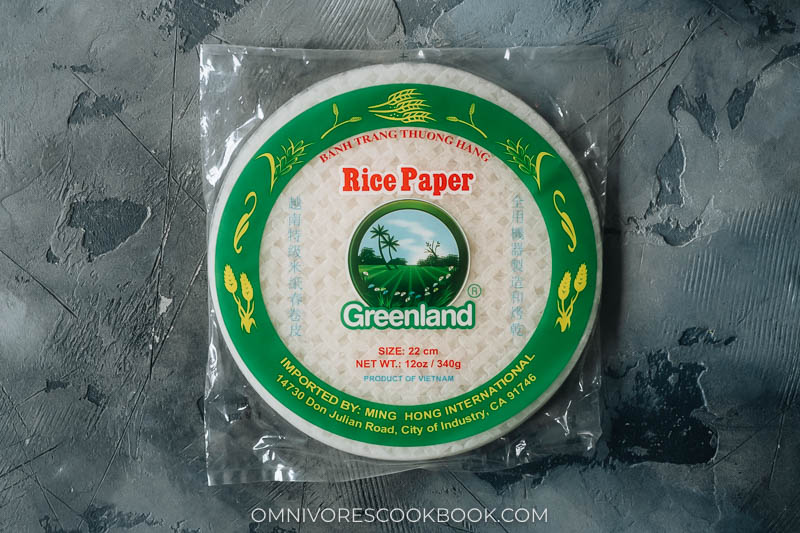
Fresh herbs
One key component of these spring rolls is fresh herbs. I listed basil, cilantro, mint, and chives in the recipe, but you do NOT have to use all of them. You should have one of them though at the very least because it elevates the flavors to an authentic level. Plus, fresh herbs are full of vitamins and minerals that will improve your immune system and keep you energized.
To get ready
Make sure you have all the ingredients chopped and cooked before wrapping. You also need a plate of water and a clean working surface (a large cutting board is perfect).
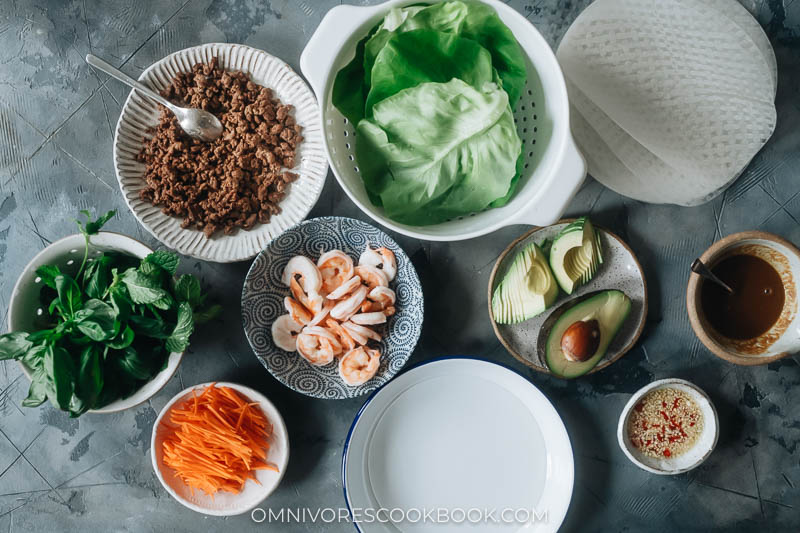
How to wrap fresh spring rolls
There are different ways to wrap spring rolls, but I want to teach you how to wrap them the professional way, like in a restaurant.
Wet the rice paper properly
To wet the rice paper, you need to dip the dry rice paper in water a few times so it softens. You want the rice paper to still feel quite stiff once done, because it will keep softening as you add the ingredients. If you do not have a large enough plate to fit the rice paper, you can use a large deep plate. Simply rotate the rice paper in the water to wet all the edges.
How to assemble the spring rolls
To build the roll, you want to work in thirds: the first third (closest to you) is the core of your roll, the middle is the herb layer, and the top third is the display layer with the shrimp.
- Spoon some ground meat into a lettuce leaf
- Wrap the meat in the lettuce to make a pocket
- Place the lettuce pocket on the lower third of the rice paper and add the avocado in the middle
- Place the carrots and herbs on the avocado and add the shrimp on the top third
- Fold the lettuce part onto the herbs
- Fold the left and the right side
- Place a sprig of herbs onto the folded part
- Keep folding to form a spring roll
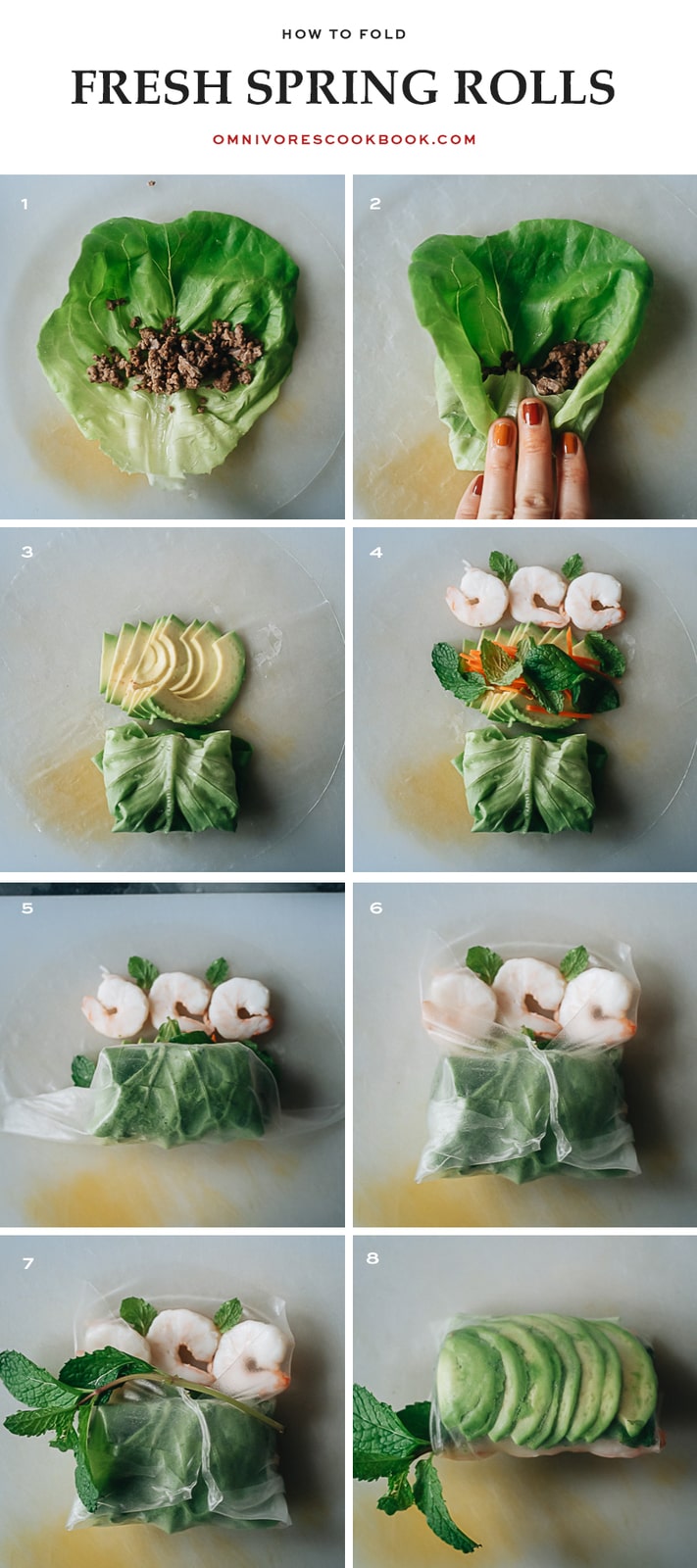
Voilà! You will be able to make a beautiful spring roll that has avocado on one side and shrimp on the other, with some fresh herbs sticking out.
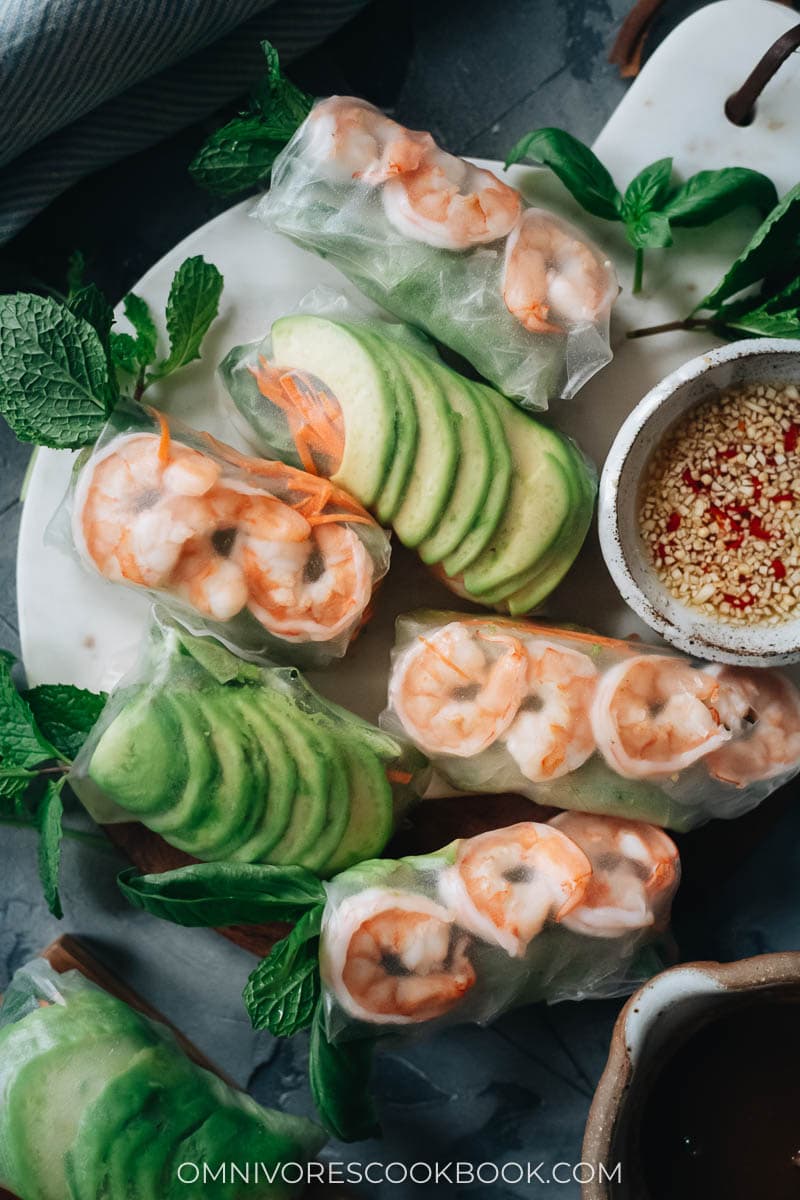
One word on storage
These spring rolls are meant to be served fresh. The wrapped rolls will last a few hours at room temperature if not served immediately. If you want to make them a bit more in advance, you should cut and cook the filling and store the ingredients in the fridge. So it will only take a short time to wrap them up before serving.
I’ve tried storing the wrapped spring rolls in the fridge and I didn’t like the result. The rice paper became tough and the insides soggy.
How to serve
In restaurants, you’ll find these spring rolls served as an appetizer. I love pairing them with a good soup for a light meal but in all honesty, you can enjoy this as your main course. And when we can have guests again, you will definitely want to impress them by serving these fresh spring rolls. They only look complicated, but once you make them, you’ll find they are easy to make and they taste just as great as in the restaurant.
Build your immunity bite for bite with these delicious fresh spring rolls. Make them once and I assure you that you’ll be making them regularly after that!
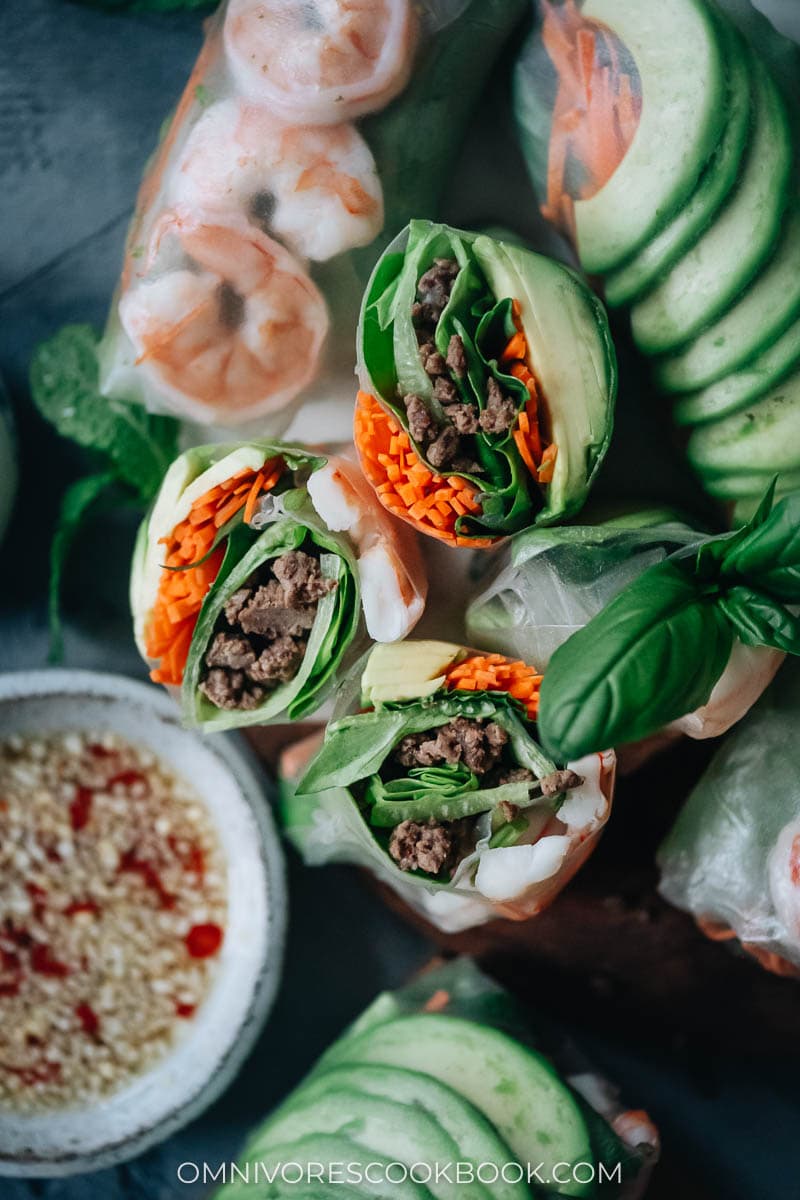
Serve the spring rolls with
- 5-Ingredient Coconut Noodle Soup
- Thai Curry Chicken Fried Rice
- Vegan Pad Thai
- Salt and Pepper Squid
- Vegetarian Pho
Want to learn more about Chinese Cooking? Sign up my newsletter to receive the 5-Day Chinese Cooking Crash Course and recipe update!
Chinese Cooking Made Easy
Are you new to this website? This free email series is a great place to start. I’ll walk you through a few of my most popular recipes and show you how and why they work. You’ll quickly start to cook better Chinese food in your own kitchen.
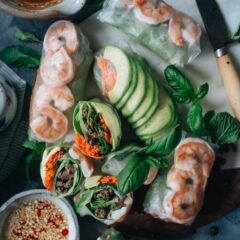
Fresh Spring Rolls with Shrimp
Ingredients
- 12 shrimp , peeled & deveined
Ground meat (Optional) (Footnote 1)
- 1 teaspoon peanut oil
- 8 oz (225 g) ground pork (beef, or chicken)
- 2 teaspoons Shaoxing wine
- 1/4 teaspoon salt
Spring roll
- 8 (22cm / 8.5”) rice paper wrappers (Footnote 2)
- 8 lettuce leaves iceberg or bibb
- 1 bunch basil cilantro, mint, and/or chives *(Footnote 3)
- 1 avocado , sliced thinly (Optional)
- 1 carrot , julienned
Sesame Sauce
- 2 tablespoons chinese sesame paste (or natural unsweetened peanut butter)
- 1 tablespoon sugar (or maple syrup)
- 1 tablespoon soy sauce
- 1 1/2 teaspoons chinkiang vinegar (or rice vinegar)
Vietnamese Chili Sauce (Nuoc Cham)
- 1 1/1 teaspoons sugar
- 2 teaspoons lime juice (or rice vinegar)
- 2 teaspoons fish sauce
- 2 cloves garlic , minced
- 1 to 2 Thai bird’s eye chilis , thinly sliced
Instructions
Prepare the ingredients
- Prepare the shrimp by boiling a small pot of water with a large pinch of salt. Add the shrimp and cook for about 1 minute, until they turn pink and are fully curled. Once cool, slice the shrimp in half lengthwise and set aside.
- If using the ground meat, heat the oil in a medium-sized pan until hot. Add the pork. Break it apart to keep the ground chunks small. Stir occasionally as you cook the pork until browned. Sprinkle with salt and add the wine. Keep cooking until all the liquid evaporates and the meat is cooked and chopped into small pieces. Transfer the meat to a plate to cool. (*Footnote 4)
- Prepare the rest of the ingredients while the proteins are cooling off.
- If you do not plan to serve the spring rolls the same day, you can now seal all the prepped ingredients in airtight containers and store them in the fridge for up to 2 days.
Make the sauce
- To make the sesame sauce, combine everything in a medium-sized bowl and stir until it forms a smooth paste. If the paste is too thick, add a few drops of water at a time and mix until your desired consistency is reached.
- To make the Nuoc Cham sauce, combine all the ingredients in a small bowl with 4 teaspoons of water. Depending on the strength of your fish sauce, you may want to add extra water or sugar according to your taste.
- The sauce can be made ahead and stored in the fridge for up to 2 days.
Assemble
- The day you plan to serve the spring rolls, place all the filling ingredients on plates for easy access. Fill a shallow but wide dish with an inch of warm water. (*Footnote 5) You should have a clean working surface like a cutting board that you can spread the rice paper on.
- Work on the rolls one at a time. Take a rice paper wrapper and pull it through the water slowly 3 or 4 times (rotate the paper if your plate is not enough to fit the whole sheet of paper). You want it to be moist but still a bit stiff, as it will absorb more water as you place your filling on it and will be fully hydrated by the time you roll it up. Lay the moistened wrapper on a flat work surface.
- To build the roll, work in thirds. Be sure to leave an inch and a half of space on the bottom and top of the wrapper. Also leave 2 inches of wrapper on the edges. (See the step-by-step photos in the blog post above for the folding steps.)
- On the first third of the wrapper lay a piece of lettuce, then place 1 to 2 tablespoons of cooked ground meat in the center. Fold it so the meat is wrapped in the middle, then place it folded side down.
- In the middle of the wrapper, lay a few slices of avocado, evenly spaced and at an angle. On top of the avocado, add a layer of carrots and a few herb leaves without the stems.
- On the top third, place three of the halved shrimp, pink side down and evenly spaced.
- Take the bottom edge of your wrapper and fold it over the third with the lettuce. Then roll the bottom third over the center. Take both sides and tightly fold them in. Tuck a sprig of the herbs at the edge of the roll, allowing them to poke out of one side. Then continue to roll over the shrimp and press lightly to seal on the remaining loose rice paper.
- Set the formed spring rolls aside on a plate. Repeat the wrapping with all of the remaining rice wrappers. Make sure to space out the spring rolls, because the rice paper will stick together if the rolls are placed against each other.
- Serve the spring rolls at room temperature with the dipping sauces. Enjoy!
Storage
- You should always serve the spring rolls the same day you wrap them. If you plan to prepare them in advance, you should prep all the ingredients and wrap the spring rolls when you’re ready to serve. The ingredients will last in the fridge for 1 to 2 days. The wrapped spring rolls will last at room temperature for a couple of hours (half a day). You can place them in a container and make sure to leave some space between the rolls, so they won’t stick together. Avoid storing wrapped spring rolls in the fridge. The rice paper will become tough and the texture not very good.
Notes
- The ground meat is not necessary but highly recommended if you do not plan to use avocado in the recipe.
- The rice paper comes in different sizes and it’s OK to use one that has similar size.
- It is not necessary to have all these herbs. As long as you have one herb to add some flavor, this recipe will work, but the more, the merrier.
- If you’re use pork or beef, you might want to line your plate with a few layers of paper towels, so it will drain off extra fat.
- You can use a fry pan, large plate, or a pie dish. But it’s OK if your plate is smaller than the rice paper. You just need to rotate the wrapper when soaking it in the water.
- The nutrition facts are calculated based on 1 of the 8 spring rolls that yield from this recipe, excluding the dipping sauce.
Nutrition

Did you make this recipe?
I’d love to hear how it turned out for you! Please take a moment to leave a 5-star rating ⭐️ and share your thoughts in the comments further down the page. It really helps others discover the recipe too.
If you give this recipe a try, let us know! Leave a comment, rate it (once you’ve tried it), and take a picture and tag it @omnivorescookbook on Instagram! I’d love to see what you come up with.
Lilja Walter is a part of the Omnivore’s Cookbook team and worked closely with Maggie to develop and test this recipe.

Nancy
delicious rolls
Heidi
These look fantastic! Gorgeous pics. Just wanted to let you know that I included a picture from this post in my weekly round-up. Linked back with photo and text links :-). You can see it here:
http://muslinandmerlot.blogspot.com/2014/03/sunday-funday-features-8.html
Happy Sunday!
Maggie
Hi Heidi, thanks for commenting and letting my know the round-up. Have a nice day! 🙂
Anne|Craving Something Healthy
Spring rolls are one of my favorite appetizers! They’re so pretty and fresh, and I love the combination of ingredients you used. Great job on your video 🙂
Maggie
Hi Anne, thanks for stopping by and commenting! I love spring rolls too, can eat a lot for a single meal. 🙂
Judit +Corina
Love these beautiful spring rolls! We enjoyed your video and now we are inspired to try it soon 🙂
J+C
Maggie
Hi Judit and Corina, thanks for stopping by and commenting! I’m so glad you like my video and hope it’ll be helpful. 🙂
whatjessicabakednext
These look divine!